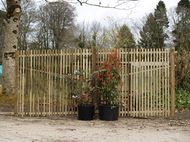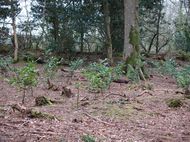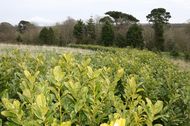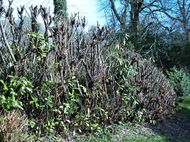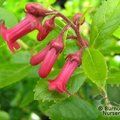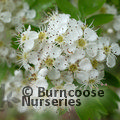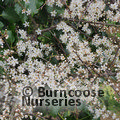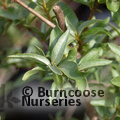- Shop Now
- Burncoose Specialities
- This Month
- Offers & Promotions
- RHS Chelsea Flower Show 2024
- 40 years at Burncoose
- Engage With Us
- Information, Help & Advice
- About Us & Our Services
- Terms & Conditions
- Log In / Register
Chapters
Planting in Coastal and Windswept Locations
Introduction
The purpose of this article is to try to help solve the problem of exposure and avoid wasting time and energy planting things which are frankly unsuitable and therefore an expensive mistake. There is no one right answer to what is suitable in any particular garden but there are often a great many more wrong answers. There is also the need for patience while your planting gets established and good luck in avoiding the worst of the weather in the early years after planting.
Fencing
So you start with a bare plot which is to be your new garden. The location is extremely exposed because it is on top of a hill or near the sea with no shelter at all. The first thought is quite naturally for fencing to create some shelter. In many locations this is simply a waste of time and money since it will not stand up to the force of the wind and may well cause far more damage to the rest of your property if it blows out of the ground as it probably will. Wind hitting an immoveable object will nearly always win!
Worse still, wind will simply bounce over a solid object like a fence and is just as strong on the other side. So your fence can actually be just a liability as far as protecting anything on the other side of it is concerned.
Think for a moment about what happens in nature and you will readily see that the filtration of wind is nature’s way.
In the 1950s at Rosewarne in Cornwall a new system of windbreaks was developed what we now call LATH or slatted windbreaks. These are not permanent or particularly durable structures. They should instead be regarded as temporary wind filtration units so that plants in their lee can become established. Lath is therefore the best outer line of defence. Similar more robust structures are used in Scotland and the North of England to prevent snowdrifts on public roads.
Modern techniques of manufacturing have replaced lath with new filtration systems made from plastic or fibre. Many greenhouses in exposed positions are now protected by large black mesh windbreaks and similar structures are used to protect fruit and vegetable crops. In gardens green mesh is more often used. However tightly woven green mesh can hold the wind and it billows so it again tends to blow away or pull over its posts. For best results a small square meshed windbreak screen with ½-inch to 1-inch square holes has much the same result in filtering the wind as the more traditional lath windbreak.
Shelter Belts
Lath fencing is probably only a realistic option in moderately windy situations. On the edge of a cliff, for instance, it will simply blow away unless you regard it as just the first line of defence.
Behind the first line of defence you then need to establish a secondary and, ultimately more robust, windbreak or wind filtering system to dissipate the effects of the wind on the garden behind where you hope to grow more choice and tender plants.
Fencing cannot just be used in isolation but, rather, in conjunction with other plants. The next and crucial choice to make is as to what are the most readily available and relatively cheap plants suitable for your particular conditions?
Here are some of the more popular choices.
Tall growing shelter belt trees for larger gardens.
Where you wish to create a long-term shelter belt there is nothing quite like Pinus radiata (often called Pinus insignis or the Monterey Pine); The Monterey Pine, for speed of growth or its ability to withstand salt sprays and wind. They live only 100 years in our high rainfall Cornish climate but are the backbone of Tresco’s outer defences and the outer protectors of most Cornish woodland gardens. For a conifer which provides more wind protection from top to bottom, Cupressus macrocarpa is also fast growing and resilient. Those of you who know Caerhays may remember passing the huge tree at the lower lodge which is in the very teeth of every southerly and westerly gale and only yards from the beach.
Traditionally, Cornish woodland gardens used beech in conjunction with and fronted by Pinus radiata, to create a dense filtration system.
The other strong contender for the best windbreak tree in coastal or windswept locations is Quercus ilex, the evergreen oak. You will see this used extensively at Trebah and Trelissick. Ilex drop their old leaves in early summer, just as the new growth emerges, but, in winter, their leaves remain unsinged by even the most severe gale. Again the attraction is that they cut out wind from top to bottom and, unlike Cupressus macrocarpa, the branches only start to split out in very old age.
In the main other native trees such as oaks are too slow growing for a good shelter belt. Other native trees like sycamores frequently have their leaves burnt off by late spring gales and salt spray. They also grow in odd shapes as a result of trying to escape persistent wind damage. In the main avoid anything other than these 3 suggestions but be prepared to be patient and also remember to stake everything with at least one stake and check all your planting after every severe gale to see that stakes have not broken or the plants broken away from their stakes.
Tall growing shrubs which make more formal and dense shelter belts.
In the hurricane of 1990 some of the laurel (Prunus laurocerasus) shelter belts at Burncoose and Caerhays were completely stripped of all their leaves but they were not dead and, more importantly, they had done their job in filtering and dissipating wind while sheltering the more choice plants behind. In coastal locations laurel should be planted thickly over a large area. Do not worry if the leaves get burnt and brown initially; given time the plant will more than cope. Plant in the spring to give young plants a relatively quiet growing season and do not plant in shade.
More formal shelter belt hedging.
There are a number of more conventional and favourite choices for garden hedges in exposed positions as well as some less well known, but perhaps equally common, hedging plants which will do the job just as well. The favourites include:-
In the less well known and less tall growing category:-
 |
These lonicera form dense thick mats of evergreen foliage which are able to withstand tremendous amounts of wind
|
|
|
|
 |
Again, these lonicera form dense thick mats of evergreen foliage which are able to withstand tremendous amounts of wind
|
|
|
|
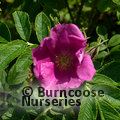 |
Rosa rugosa is often thought of as the most prickly of roses best suited to deterring unwanted children, dogs or cats from your garden. However, as a deciduous plant which suckers readily into dense clumps, it is not at all a bad windbreak plant even though it grows to only about 3 feet.
|
|
|
|
 |
Another group of plants which make excellent evergreen windbreaks are the Olearias. Several species come from coastal areas of New Zealand where they are well used to wind. Olearia macrodonta is a firm favourite with its glossy grey leaves and attractive daisy like flowers. For those lucky enough to live on the Isles of Scilly or other seaside locations in West Cornwall, Olearia traversii would be the hedging plant best suited to salt laden gales.
|
|
|
|
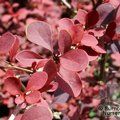 |
Several different types of Berberis make attractive hedges but only the evergreen species such as Berberis thungbergii are really good windbreak plants. Another favourite with really aggressive prickles is Berberis ottawensis ‘Superba’ but this would need to be planted with some other evergreen subject for best effect.
|
|
|
|
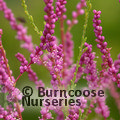 |
Tamarisk have the great advantage of being able to grow in sea sand with only the most minimal amounts of conventional soil. The plants grow to a great age and can develop huge gnarled trunks in seaside locations but, if clipped and trimmed from an early age, they make an excellent beach hedge
|
|
|
|
Putting it all together
Sacrifical Plants
In our imaginary garden we now have our lath windbreak and our laurel backup and then, thirdly, our more conventional escallonia hedge. We have created 3 tiers of wind protection which we expect to be scorched to a greater or lesser extent especially in the early years. We expect losses and, in coastal areas, we may also expect rabbit damage so wires and tree spirals are an essential part of the planting process. However this will all take time to grow up and you may well still not have enough shelter to enable you to grow more choice plants in the lee.
It is perhaps time to introduce the concept of ‘Sacrificial Plants’! These are generally quick growing but unattractive plants which should be viewed as utterly expendable. They may precede your new windbreaks or they may form a second line of defence which can perhaps be cut down and removed later.
At its most basic level there is nothing really to beat gorse (Ulex europaeus) far withstanding the worst of the elements and cutting out under-draught in a cliff situation but you may well not really want it actually in your garden!
At Caerhays and Burncoose, as well as most Cornish woodland gardens, the traditional sacrificial plants are Rhododendron ponticum. This will colonise almost anywhere and form a thick protective layer. Although ponticum has been in the UK since the middle of the 18th Century our masters at Defra still consider it to be a non-native and invasive, and therefore “BAD”.
However as a ‘Sacrificial plant’ it is second to none and the fact that it is now being killed off in some parts of the country by Phytophthera ramorum is not a cause for rejoicing as Defra would have us believe – quite the reverse in fact.
A more daring approach which is used both at Caerhays and Burncoose is to use camellias as sacrificial plants. Like ponticum they grow well in partial shade and they bulk up quickly. If you use the more common williamsii varieties such as St Ewe orDebbie they make excellent screens especially for planting something more choice by way of a rhododendron in the lee.
There are many other quick growing sacrificial plants with short lives which can quite literally get thrown away after a few years. But, as they grow exponentially, they quickly provide some basic shelter. Prime examples of this might include Lavatera, Hippophae rhamnoides or Atriplex halimus.
 |
|
|
|
|
 |
When available. |
|
|
|
 |
|
|
|
|
 |
|
|
|
|
 |
|
|
|
|
 |
|
|
|
|
 |
|
|
|
|
Ideal Plants for Coastal/Windswept Planting
These will tolerate the most extreme salt sprays but are better off protected by some shelter belt planting.
Our favourite bamboos:-
Best windbreaks
 |
|
|
|
|
 |
|
|
|
|
 |
|
Best for underdraught
 |
|
|
|
|
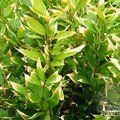 |
|
Best for specimen features
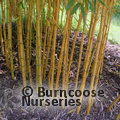 |
|
|
|
|
 |
|
|
|
We also suggest looking in the following categories for more plants ideal for these planting conditions:-
- Sturdy larger growing and specimen plants
- Smaller growing or rock plants
- A selection of plants - needing more protection
- Climbers which will tolerate exposure in coastal gardens
Conclusion
In 2000 Burncoose occupied the huge Monument Site at the Chelsea Flower Show and part of the stand was devoted specifically to coastal planting. From this came a number of commissions to create coastal gardens in Cornwall and Devon as well as in Wales and along the South Coast of England. You can see some of our work at The Port Pendennis Harbour Village and Marina in Falmouth and you do not get to plant much closer to the sea than that!
If you plant in the teeth of the wind it is silly to pretend that you will not suffer a good deal of scorching and level of casualties which might well not be acceptable in other situations. Planting in exposed positions must therefore be understood as an ongoing struggle to create a series of barriers to the wind to filter it down to levels where more choice plants can then be grown.
Click here to see a coastal garden we have been landscaping
Charles Williams.


